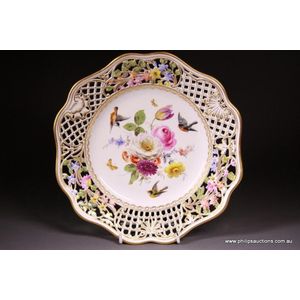Victorian Staffordshire Figure of David Garrick as Richard III
You must be a subscriber, and be logged in to view price and dealer details.
Subscribe Now to view actual auction price for this item
When you subscribe, you have the option of setting the currency in which to display prices to $Au, $US, $NZ or Stg.
- Flatback - As the name indicates, flatback Staffordshire figures are characterized by their undecorated flat backs and are typically designed to be displayed to sit on a narrow mantlepiece. They often made in pairs and depict popular scenes or characters from literature, mythology, or history, and they were prized for their intricate details and bright colours.
These figures were popular in England during the 19th century, and they were widely produced and sold by a number of different Staffordshire based manufacturers.
In the late 1880's to the early 1900s Royal Worcester also manufactured a series of floral decorated jugs which are termed 'flat backs'. - Earthenware - A basic ceramic material that is fired at a low temperature. Earthenware is the basis of almost all ancient, medieval, Middle Eastern and European painted ceramics. After firing, the colour is the colour of the clay when it is dug from the ground: buff, brown and red. It is not waterproof until glazed. Creamware is a type of earthenware covered with a transparent lead glaze. Majolica, faience and delft are also earthenware covered in an opaque white tin glaze.
- Victorian Period - The Victorian period of furniture and decorative arts design covers the reign of Queen Victoria from 1837 to 1901. There was not one dominant style of furniture in the Victorian period. Designers used and modified many historical styles such as Gothic, Tudor, Elizabethan, English Rococo, Neoclassical and others, although use of some styles, such as English Rococo and Gothic tended to dominate the furniture manufacture of the period.
The Victorian period was preceded by the Regency and William IV periods, and followed by the Edwardian period, named for Edward VII (1841 ? 1910) who was King of the United Kingdom and the British Dominions and Emperor of India for the brief period from 1901 until his death in 1910.
This item has been included into following indexes:
Visually similar items

A Sevres trinket box, depicting a classical scene on lid, hand painted on porcelain, dated 1772 (T) in two L interlaced. (a/f)

A Meissen reticulated cabinet plate, late 19th to early 20th century, Intricately painted with a loose floral bouquet surrounded by butterflies and birds in flight upon a white ground, the scalloped border with a lattice weave design and pierced floral res

A Victorian Staffordshire figure of noted architect and gardener Joseph Paxton with his daughter Annie, circa 1860, the press moulded flatback group depicting the architect of the Crystal Palace accompanied by his daughter Annie, noted for posing upon a gi

A large pair of white spaniels with glass eyes in the Staffordshire manner, late 19th to 20th century, of simple modelling with bright and fancy gold decoration indicative of a later production era, with unglazed bases and release holes. Height 33 cm
